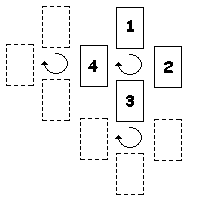|
|
|
|
|||
| FoolQuest.com Web Archive of http://members.bellatlantic.net/~d.s.mitchell/divination04.htm |
|
||||
|
|
|
||||
Wicca 101 - Divination - Tarot Sample Layouts On this page we are going to look at a few sample layouts, the layouts I've included are a few of my favorites however they are not the only ways to layout cards for readings, as a matter of fact I've seen several different explanations for the Celtic Cross layout and this is only one of the many.
In the Celtic Cross layout we first choose a card to represent either ourselves or our question, it is placed into the first (1) position. The deck is then shuffled and the cards are laid out in the order that they are shown in the diagram. (2) the card that covers you, this card represents the opposing forces, the conflict that is keeping you from a successful resolution. (3) beneath you, this card represents the foundation for the question and relates to the past. (4) behind you, influences that have just passed. (5) crowns you, influences that may yet come into being. (6) before you, things in the near future relating to the question. On the right hand side we have (7) negative feelings, this card relates to card three since negative feelings come from the distant past. (8) the environment, this card relates to card four since the environment is in the present. (9) subjective hopes and ideals, this card relates to card five since hopes and ideals are in the near future. (10) outcome, this card relates to card six since the outcome is in the future. When reading it is useful to read the cards in order to get a feel for the foundation of the question and how it has progressed over time, but once you get to cards seven through ten you hop back to their related cards to better flesh out meaning.  Circle of Life Layout As a contrast to the regimented Celtic Cross the Circle of Life layout is more flexible, starting with the initial four cards representing (1) the foundation for the question or the past, (2) the question, (3) one possible path or solution for dealing with the question, and (4) the probable outcome from choosing this path. Once the initial cards have been laid down you can build on any of the four with its own circle layout to further flesh out the reading. If for instance you don't think the possible path is spelled out clearly enough you can lay down additional cards off of card three and read them together to get a more clear answer. The flexibility of this spread lends itself to ill-defined questions.  Three by Three Layout In the quick three layout the first three cards are read together to indicate the question, after they have been read the next three are laid out and indicate the obstacles in the way of you reaching the outcome, the final three cards are laid out last and indicate the final outcome of overcoming your obstacles.  Quick Three Layout Hopefully this one is self-explanatory and is meant to show that fancy layouts aren't necessary if you just want a quick answer or don't feel comfortable remembering which card goes where. Simply read the cards how you feel, let them tell you a story. With time and practice you will find the layout that works best for you. |
|
|
|
|
|
|
|||
| FoolQuest.com Web Archive of http://members.bellatlantic.net/~d.s.mitchell/divination04.htm |
|
||||
|
|
|
||||